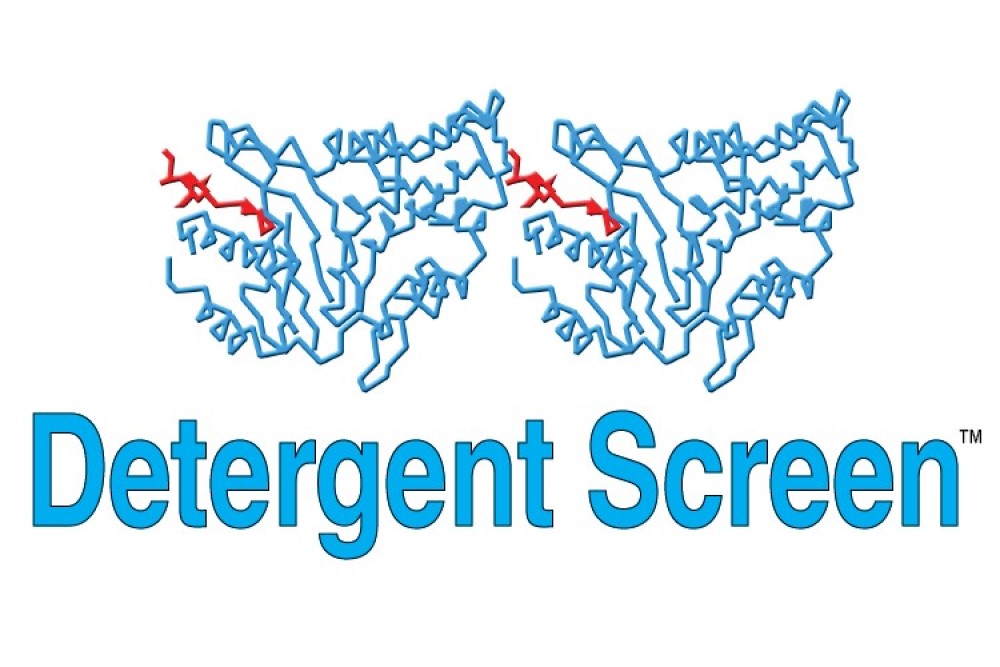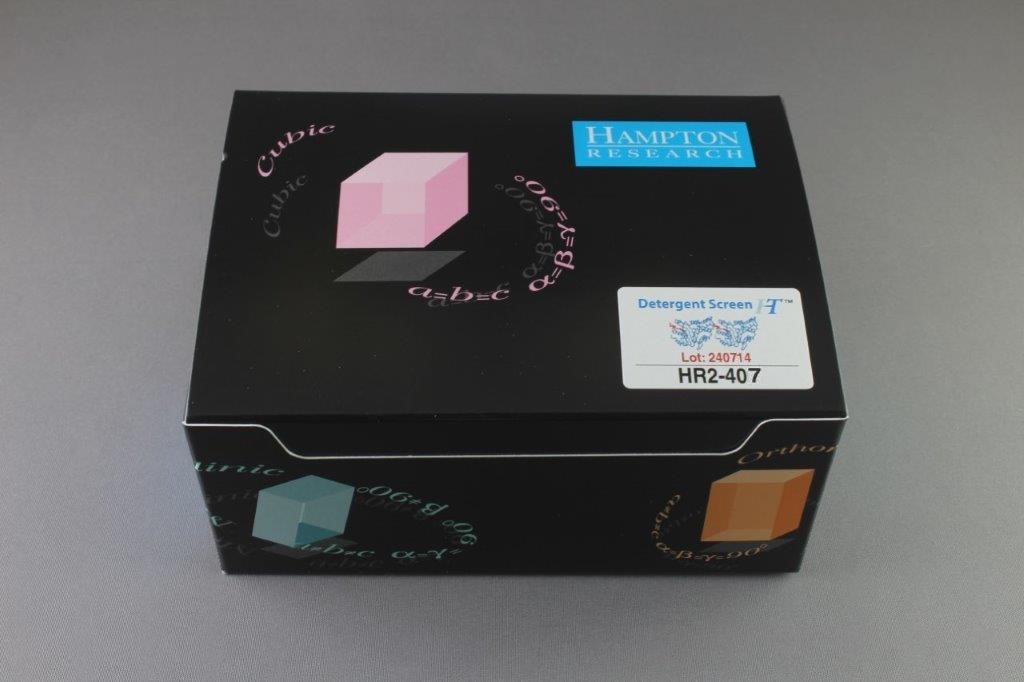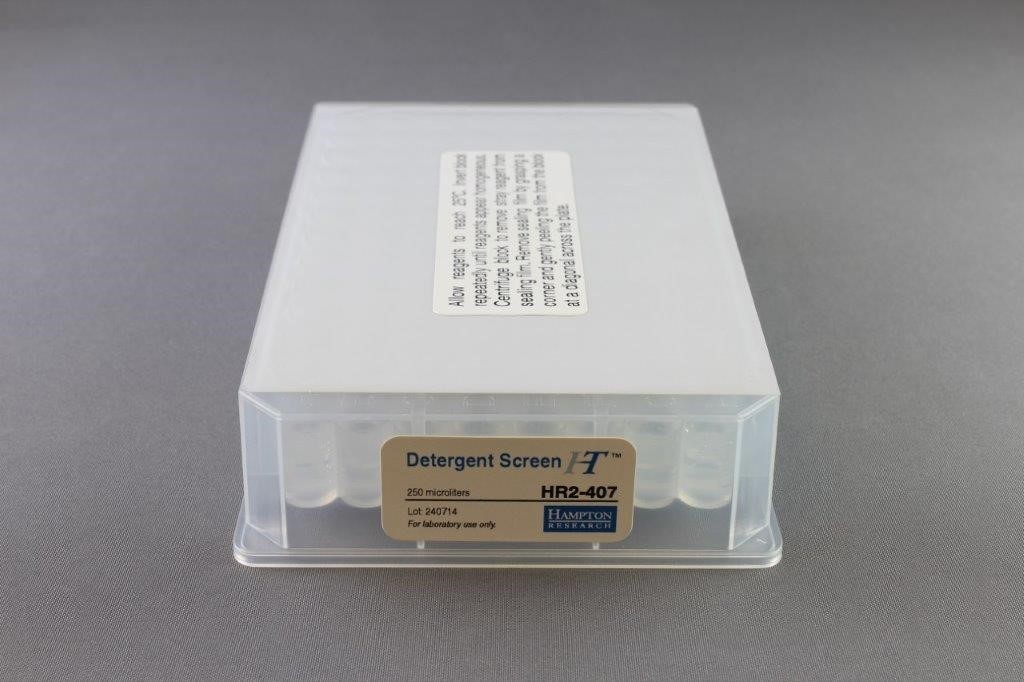Detergent Screen-Hampton洗涤剂删选试剂
上海金畔生物代理Hampton research品牌蛋白结晶试剂耗材工具等,我们将竭诚为您服务,欢迎访问Hampton research官网或者咨询我们获取更多相关Hampton research品牌产品信息。


Products > Optimization Screens > Detergent Screen > Detergent Screen
Detergent Screen
Applications
- Manipulate sample-sample and sample-solvent interactions, including non-specific aggregation due to hydrophobic interactions, to alter sample solubility, or obtain or improve crystalline samples.
Features
- Developed at Hampton Research
- For use with either membrane or soluble proteins
- Compatible with vapor diffusion, microbatch, and free interface diffusion methods
- 96 Deep Well block format
- Classification of Detergents in screen
- Ionic
- Non-ionic
- Zwitterionic
- Non-detergent Sulfobetaines
Description
Note: HR2-407 Detergent Screen is a new formulation and has replaced the original HR2-406 Detergent Screen HT.
For crystallization to take place, a protein must be soluble in aqueous solution. Ideally the sample should be homogeneous, monodisperse, and in a state of aggregation conducive to interactions which will promote the nucleation and subsequent growth of a crystal. Unfavorable aggregation can compete with, obstruct, and prevent the normal ordering or the sample into a crystal. Many proteins, typically membrane proteins, membrane associated proteins, and soluble proteins contain hydrophobic residues on the surface which can lead to non-specific aggregation, a deterrent to solubility and crystallization. Mild, biological detergents can perturb and manipulate hydrophobic sample-sample and sample-solvent interactions. Incorporating detergents into the solubilization or crystallization reagent during screening and optimization is a popular and effective strategy for identifying conditions which promote and enhance solubility and crystallization. Besides improving the crystallization properties for some proteins and nucleic acids, detergents have also been shown to alleviate problems of twinning and secondary nucleation and can also produce different crystal forms.
Since it can be difficult to impossible a priori to predict and select which detergent or solubilizing agent will minimize the general nonspecific interactions yet at the same time sustain the specific interactions necessary for crystallization, the screening of a portfolio of detergent and solubilizing reagents is an efficient and effective strategy to identify the appropriate and best detergent reagent. The Detergent Screen is a set of solubilization and crystallization specific, mild, biological detergent reagents in a ready to use format at concentrations appropriate for solubility and crystallization screens. The Detergent Screen format allows one to identify a detergent effect as well as help select the best detergent reagent.
Each Detergent Screen kit contains 96 unique detergents. 0.25 ml of detergent solution is formulated at 10 times the reported CMC (unless otherwise noted) in sterile filtered deionized water. The Detergent Screen kit contains 96 solutions in a single Deep Well block, a single sheet of AlumaSeal II Sealing Film, User Guide, Formulations, and Scoring Sheet.
操纵样品-样品和样品-溶剂相互作用,包括由于疏水相互作用引起的非特异性聚集,以改变样品溶解度,或获得或改善结晶样品。
特征
在汉普顿研究中心开发
用于膜蛋白或可溶性蛋白
与蒸汽扩散、微批次和自由界面扩散方法兼容
96 深井块格式
屏幕清洁剂的分类
离子
非离子
两性离子
非洗涤剂磺基甜菜碱
描述
注意:HR2-407 Detergent Screen 是一种新配方,取代了原来的 HR2-406 Detergent Screen HT。为了发生结晶,蛋白质必须溶于水溶液。理想情况下,样品应该是均质的、单分散的,并且处于有利于相互作用的聚集状态,这将促进晶体的成核和随后的生长。不利的聚集会竞争、阻碍和阻止正常排序或样品成晶体。许多蛋白质,通常是膜蛋白、膜相关蛋白和可溶性蛋白,其表面含有疏水残基,这会导致非特异性聚集,阻碍溶解性和结晶。温和的生物去污剂会干扰和操纵疏水性样品-样品和样品-溶剂相互作用。在筛选和优化过程中将去污剂加入增溶或结晶试剂中是一种流行且有效的策略,用于识别促进和增强溶解度和结晶的条件。除了改善某些蛋白质和核酸的结晶特性外,去污剂还被证明可以缓解孪晶和二次成核问题,并且还可以产生不同的晶型。由于很难甚至不可能先验地预测和选择哪种去污剂或增溶剂将最大限度地减少一般的非特异性相互作用,同时维持结晶所需的特定相互作用,因此筛选去污剂和增溶剂组合是一种有效的方法。和有效的策略来确定合适的和最好的洗涤剂试剂。 Detergent Screen 是一组溶解和结晶特异的、温和的生物去垢剂试剂,以适合溶解度和结晶筛选的浓度提供即用型形式。洗涤剂屏幕格式允许人们识别洗涤剂效果并帮助选择最佳洗涤剂试剂。
每个洗涤剂筛网套件包含 96 种独特的洗涤剂。将 0.25 ml 洗涤剂溶液按报告的 CMC(除非另有说明)的 10 倍配制在无菌过滤去离子水中。 Detergent Screen 套件在单个 Deep Well 模块中包含 96 种溶液、一张 AlumaSeal II 密封膜、用户指南、配方和评分表。
Detergent Screen



CAT NO
HR2-407
NAME
DESCRIPTION
0.25 ml, Deep Well block format
PRICE
$454.00
cart quote
Support Material(s)
 HR2-407 Detergent Screen Documents
HR2-407 Detergent Screen Documents HR2-407 Detergent Screen SDS
HR2-407 Detergent Screen SDS Detergent Screen Formulation & Scoring Data
Detergent Screen Formulation & Scoring DataRelated Item(S)
- Individual Detergent Screen Reagents
References
1. Protein crystallogra phy with non detergent sulfobetaines. Laurent Vuillard, Bassem Baalbakia, Mogens Lehmanna, Sofie Norager, Pierre Legrand, Michel Roth. 1996, J Cryst Growth 168 150-154.
2. A defined protein–detergent–lipid complex for crystallization of integral membrane proteins: The cytochrome b6f complex of oxygenic photosynthesis. Huamin Zhang, Genji Kurisu, Janet L. Smith, and William A. Cramer. Proc Natl Acad Sci U S A. 2003 April 29, 100(9): 5160–5163.
3. An experiment regarding crystalliza tion of soluble proteins in the pres-ence of b-octyl-glucoside. McPherson A., Koszelak, S., Axelrod, H., Day, J., Williams, R., McGrath, M., Robinson, L., and Cascio, D. 1986, J. Biol. Chem. 261: 1969.
4. McPherson A. (1999). Crystallization of Biological Macromolecules. Cold Spring Harbor Laboratory Press, 253-258.
5. Crystallization of membrane proteins. Edited by Hartmut Michel, CRC Press, 1991.
6. Crystallization of nucleic acids and proteins, Edited by A. Ducruix and R. Giege, The Practical Approach Series, Oxford Univ. Press, 1992 175-191.
7. The effects of neutral detergents on the crystallization of soluble proteins. A. McPherson et al. 1986, J. Crystal Growth, 76, 547-553.
8. Kuhlbrand, W., Quarterly Rev. Biophys., 21, 429, 1988.
9. Garavito, R.M., & Picot, D., Methods, A Companion to Methods in En-zymology, 1, 57, 1990.
10. The growth and characterization of membrane protein crystals. R. Mi-chael Garavito, Zora Markovic-Housley, John A. Jenkins. 1986, Journal of Crystal Growth, 76, 701-709.
11. Screening and optimization strategies for macromolecular crystal growth. R. Cudney, S. Patel, K. Weisgraber, Y. Newhouse and A. McPherson. 1994, Acta Cryst. D50, 414-423.
